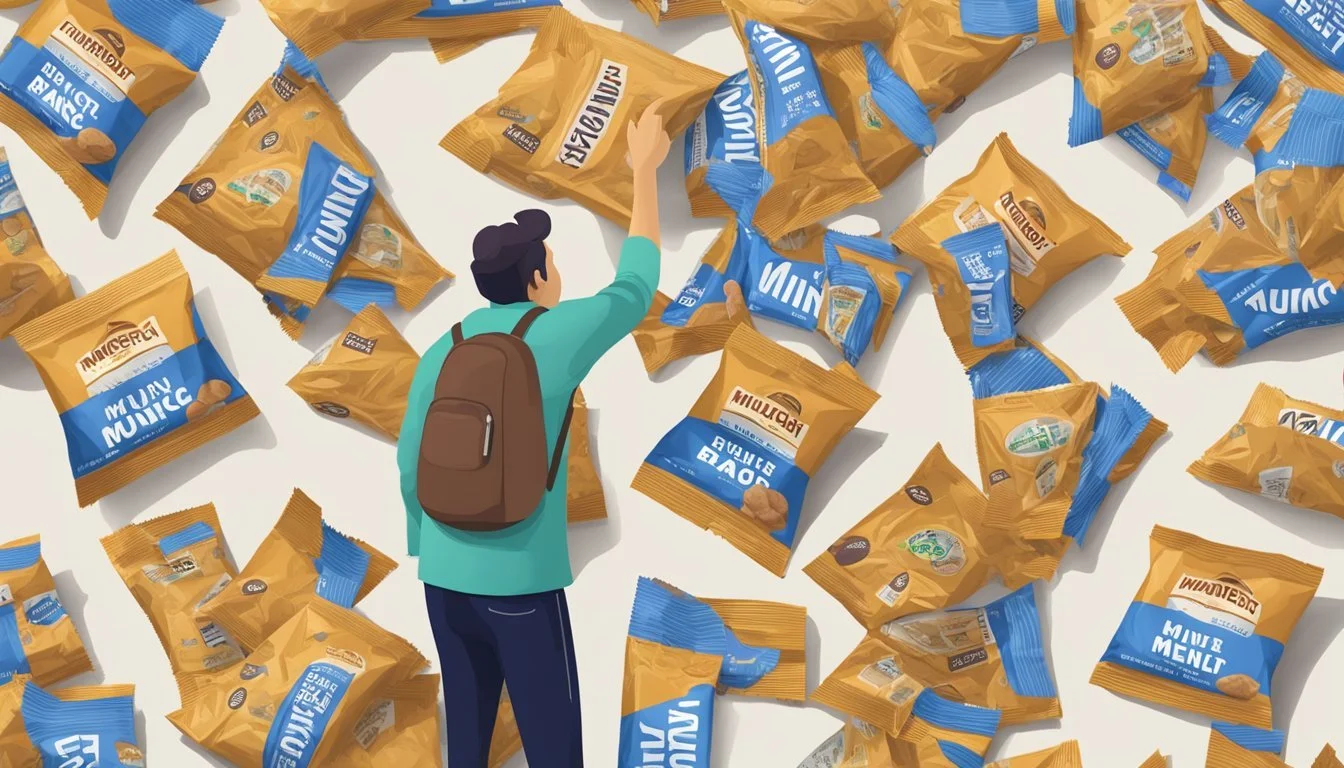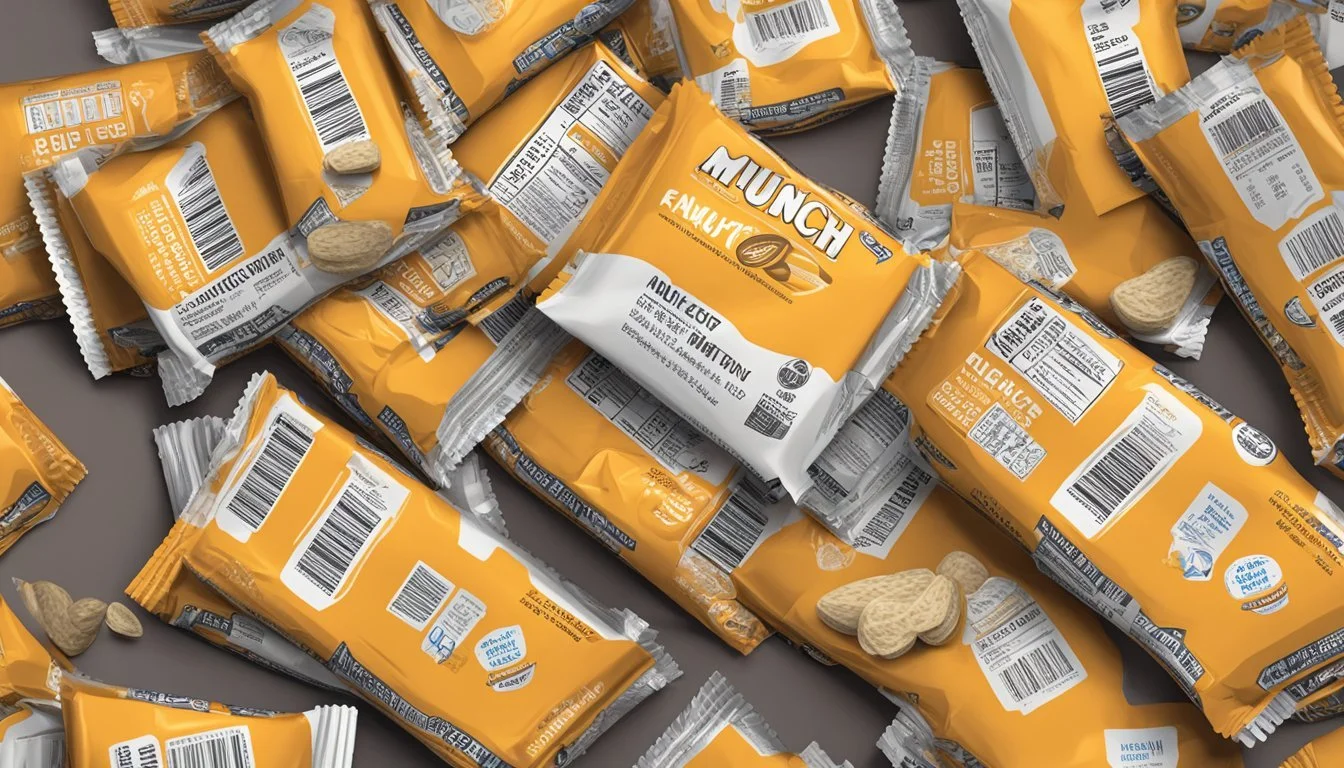How Many Servings of Munch Peanut Bars Is Too Much
Health Insights and Recommendations
Consuming more than two servings of Munch Peanut Bars per day can pose health risks. Each bar contains 220 calories and 15 grams of fat, which can quickly add up, leading to potential weight gain and other health concerns.
Incorporating multiple bars into a daily diet can lead to excessive intake of saturated fat and sugar, which could contribute to heart disease and diabetes if not moderated. While an occasional treat is fine, consistently eating too many can offset an otherwise balanced diet.
For those who enjoy the crunchy and satisfying taste of Munch Peanut Bars, it’s best to enjoy them in moderation. Keeping consumption to one bar a few times a week can help maintain a healthy lifestyle without compromising on the pleasure of snacking.
Understanding Munch Peanut Bars
Munch Peanut Bars are a nutrient-dense snack with a relatively simple composition. They offer various benefits, especially from their main ingredient, peanuts. It is crucial to comprehend their nutritional impact and the additives they contain.
Composition and Nutritional Profile
A significant portion of Munch Peanut Bars is composed of peanuts, which are a rich source of protein and healthy fats. Each bar typically contains 220 calories, with 15 grams of total fat and 6 grams of protein.
The fat content includes saturated fat (3.5 g) and healthier unsaturated fats. Additionally, there are 17 grams of carbohydrates and 13 grams of sugar per serving. The sodium content is relatively modest at 140 mg.
Such a nutritional profile makes Munch Peanut Bars an energy-dense option, suitable for quick snacks.
Benefits of Eating Peanuts and Nut Products
Peanuts provide numerous health benefits due to their high content of protein, fiber, and vitamins. They help in maintaining muscle health and supporting metabolic activities.
Healthy fats in peanuts, including polyunsaturated and monounsaturated fats, contribute to heart health by reducing bad cholesterol levels. The fiber helps in enhancing digestive health.
Peanuts are also an excellent source of essential minerals like magnesium and potassium, crucial for various bodily functions. Including peanuts in the diet can support overall well-being and aid in maintaining a balanced diet.
Common Ingredients and Additives in Snack Bars
Munch Peanut Bars have simple yet effective ingredients. The key components include peanuts, sugar, butter, corn syrup, palm oil, salt, and soy lecithin. These elements ensure the bar's characteristic flavor and texture.
Soy lecithin acts as an emulsifier, helping to blend ingredients smoothly. The use of corn syrup and sugar contributes to the bar's sweetness and binding, while butter adds a rich flavor.
However, ingredients like palm oil raise concerns due to their environmental impact, making it essential for consumers to be aware of their choices. The inclusion of salt adds to taste, balancing the sweetness and enhancing the overall flavor profile.
Health Considerations and Dietary Guidelines
Consuming Munch Peanut Bars in moderation is crucial to maintaining a healthy diet. This section examines the recommended intake of fats and sugars, the health impact of excessive snacking, and considerations for those with food allergies or sensitivities.
Recommended Dietary Intake of Fats and Sugars
The American Heart Association recommends limiting added sugars to 100 calories per day for women and 150 calories per day for men. The Daily Value (DV) for added sugars set by the FDA is 200 calories. When consuming Munch Peanut Bars, it's essential to monitor these intake levels.
Watching total fat intake is equally critical. For a balanced diet, it's suggested to keep daily fat consumption between 20-35% of total calories. This helps manage weight and reduces the risk of heart disease and high blood pressure.
Impact of Excessive Snacking on Health
Frequent consumption of high-calorie snacks like Munch Peanut Bars can contribute to weight gain and obesity. Obesity increases the risk of various health issues, including heart disease, diabetes, and certain cancers.
Excessive snacking can also lead to spikes in blood sugar levels, contributing to high blood pressure and inflammation. Managing snack portions and timing can help maintain a healthy weight and reduce the risk of chronic health conditions.
Understanding Food Allergies and Sensitivities
Munch Peanut Bars contain peanuts, a common allergen that can cause severe reactions in those with peanut allergies. Symptoms of a peanut allergy can range from mild hives to anaphylaxis.
For individuals with sensitivities or allergies, carefully reading ingredient labels and being aware of potential cross-contaminations is crucial. Those with peanut allergies should avoid Munch Peanut Bars and seek alternative snacks less likely to cause adverse reactions. Ensuring access to safe food options is vital to maintain dietary health and avoid life-threatening situations.
Factors Affecting Nutrient Absorption
Several factors influence how efficiently the body absorbs nutrients from food. These factors include the presence of dietary fiber and phytic acid, the impact of various minerals, and the interactions between fats and minerals.
Role of Dietary Fiber and Phytic Acid
Dietary fiber, though essential for digestive health, can bind to minerals and hinder their absorption. Phytic acid, present in whole grains and legumes, binds to minerals such as iron, zinc, and calcium. This binding creates compounds that the body cannot easily absorb. Foods high in phytic acid can lead to mineral deficiencies if not properly balanced.
However, soaking, fermenting, or sprouting these foods can reduce phytic acid levels and improve mineral bioavailability. For people consuming high-fiber diets, these preparation methods are crucial for maximizing nutrient absorption.
Influence of Minerals on Health
Taking large doses of one mineral can negatively impact the absorption of others. For instance, high doses of calcium can reduce the absorption of zinc, iron, and magnesium. This competitive inhibition occurs because multiple minerals may rely on the same transport pathways in the gut.
A balanced intake of minerals is essential, as imbalances can lead to deficiencies. For example, excessive zinc supplementation might cause copper and iron deficits, affecting overall health. It’s important to consume a varied diet to ensure adequate intake and absorption of all necessary minerals.
Interactions Between Fats and Minerals
Fats play a significant role in the absorption of fat-soluble vitamins and some minerals. Minerals like calcium and magnesium are better absorbed in the presence of dietary fats. Fats enhance the solubility and transport of these nutrients through the intestinal wall.
Moreover, some fatty acids form complexes with minerals, aiding in their absorption. Thus, including healthy fats in the diet can support better mineral absorption and utilization. Understanding these interactions helps in designing diets that optimize nutrient intake and tackle potential deficiencies.
Guidelines for Healthy Snack Consumption
It is essential to make informed choices about snack consumption to maintain a balanced diet. Focusing on the nutritional content and the serving sizes of snacks can help in managing weight and overall health.
How to Choose a Healthy Snack Bar
When selecting a snack bar, consider calories, sugar content, and the types of fats present. A snack bar should ideally have a good balance of proteins, fiber, and healthy fats like unsaturated fats.
Calories: Aim for snack bars that are between 100-200 calories per serving.
Sugars: Keep the added sugars below 10 grams per serving.
Fats: Choose bars with higher amounts of unsaturated fats and minimal saturated fats.
Reading labels and ingredient lists can aid in identifying a nutritious snack bar. Avoid bars with high-calorie counts and artificial ingredients.
Balancing Snack Intake with Overall Diet
Incorporating snacks like Munch Peanut Bars into a daily diet requires balancing them with other dietary components.
Serving Size: Limit to one serving per day to manage calorie intake.
Diet: Complement such snacks with meals rich in fruits, vegetables, whole grains, and lean proteins.
Fat: Monitor the intake of fats to ensure a healthy balance between omega-3 and omega-6 fatty acids. A ratio close to 1:1 is beneficial.
By maintaining a proper balance, snacks can help in sustaining energy levels and contributing to healthy weight management.
Alternative Options for Nut-Based Snacks
Consider healthier alternatives to snack bars for variety and additional nutritional benefits.
Almonds: A good source of healthy fats and fiber.
Nut Butter: Spread on whole-grain bread or slices of fruit for a nutritious option.
Legume Family: Chickpeas and lentils can be roasted for a crunchy snack.
These alternatives provide beneficial nutrients and can serve as substitutes for standard snack bars, ensuring that the intake of calories and fats aligns with overall health goals.
Potential Adverse Effects of Overconsumption
Consuming too many Munch peanut bars can lead to various health issues. This section covers recognizing excessive intake signs, long-term health risks, and managing negative reactions.
Recognizing the Signs of Overindulgence
The first signs of overconsumption include digestive issues. Bloating, gas, and diarrhea are common symptoms due to high fiber content and added oils.
Those with peanut allergies might experience tingling in the mouth or a runny nose, while severe allergies can cause shortness of breath and throat swelling.
High sodium in some varieties can lead to increased blood pressure and fluid retention, making it essential to monitor portions.
Long-Term Health Risks of Excess Snacking
Regularly overeating Munch peanut bars can increase the risk of obesity due to high-calorie content. This can lead to high blood pressure and arterial blockages.
Consuming excessive amounts may contribute to high total cholesterol levels, posing a risk to cardiovascular health.
The bars often contain omega-6 fatty acids, which, in excess, may exacerbate inflammatory conditions like arthritis. Elevated insulin levels from frequent snacking could also lead to insulin resistance.
Managing and Mitigating Negative Reactions
To manage negative reactions, it's crucial to maintain moderation. Drinking plenty of fluids can help alleviate digestive problems and bloating.
People can also consider alternatives with lower sodium to avoid high blood pressure. If experiencing an allergic reaction, antihistamines might offer temporary relief, but consult a healthcare professional for persistent symptoms.
For those with digestive sensitivity, soaking or choosing anti-nutrient reduced bars may minimize the risk of gastrointestinal issues.
Evaluating Consumer Choices and Behaviors
When analyzing consumer choices with Munch Peanut Bars, it’s essential to consider consumption trends, seasonal effects, and cost-effectiveness.
Consumer Trends in Snack Bar Consumption
Consumers are increasingly seeking snacks that balance taste and nutritional value. With 6 grams of protein per bar, Munch Peanut Bars appeal to those needing a quick protein boost. The trend towards transparent labeling and natural ingredients also bolsters the appeal.
However, the relatively high sugar content remains a concern for health-conscious buyers. Limiting consumption to fit daily sugar intake recommendations can help maintain a balanced diet.
Effect of Seasons on Snack Preferences
Seasonal changes significantly influence snack preferences. During colder months, there is generally a higher demand for calorically dense and comforting snacks. Munch Peanut Bars, with their sweet and salty profile, fit this preference perfectly.
In warmer seasons, consumer interest might shift towards lighter, refreshing snacks. Retailers and marketers should adjust their strategies accordingly, promoting Munch Peanut Bars during peak seasons when they align with consumer cravings.
Cost-Effectiveness and Value Propositions
Munch Peanut Bars are positioned as a cost-effective snack option, often sold in bulk packages. At approximately $1.78 per ounce according to Walmart, they provide value through affordability and convenience.
When evaluating cost-effectiveness, it's important for consumers to consider the nutritional benefits versus cheaper alternatives. The transparency in ingredient lists and the protein content offer a strong value proposition, especially when compared to other snacks that might not meet the same nutritional standards.







